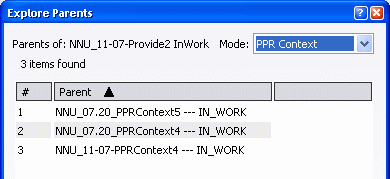Navigating on PPR Data | ||||
|
| |||
Explore
The Explore command enables you to select an object and explore it as root in a new Navigation window.
- In the PPR tree or in the 3D, right-click an object
and select Explore or select the object and then select
Edit > Explore.
When you select a product, a new Navigation window opens with that product as root node in the tree.
When you select a resource, a new Navigation window opens with that resource as root node in the tree.
When you select a process, it must be used by a PPR Context in order to be explored:
- When the process is used in only one PPR Context, the
PPR Context will be explored in a new Navigation window
as a root object. In the window, there will be a single
branch expanded from the PPR Context to the selected process
to be explored.
For example:

- When the process is used by several PPR Contexts, the
Explore Parents dialog box is displayed. This allows you
to choose in which context you want to explore the Process.
For example:

For more information, see Exploring Parents.
When you select a system:
- If only one PPR Context contains the selected system, this PPR Context is explored.
- If several PPR Contexts contain the selected system, the Explore command switches to Explore Parent to enable selection of the desired PPR Context.
When you select an operation:
- If only one PPR Context contains the selected operation, this PPR Context is explored.
- If several PPR Contexts contain the selected operation, the Explore command switches to Explore Parent to enable selection of the desired PPR Context. As an operation has always at least one parent system, the explored PPR Context is explored with the selected operation as non-direct children, and at least one system as intermediate-level object, and potentially other intermediate-level systems and operations.
Notes:
- A PPR Context cannot be filtered. Only Products, Resources and Processes can be filtered. It is possible to apply different filters to Products, Resources and Processes. See Filtering Data in VPM Navigator for more information.
- Smart Completion and Implement links analysis via the Compass are not available in an Explore (PPR Context) window.
- When the process is used in only one PPR Context, the
PPR Context will be explored in a new Navigation window
as a root object. In the window, there will be a single
branch expanded from the PPR Context to the selected process
to be explored.
For example:
![]()
Expand All
The Expand All command enables you to expand the complete sub-tree of the selected node.
- Select a node in the tree, then click Expand All
 or select View > Expand All.
Note that you can also right-click the selected node and select
Expand All.
or select View > Expand All.
Note that you can also right-click the selected node and select
Expand All.All branches of the selected object are expanded down to their leaf components.
![]()
Refresh and Collapse
The Refresh and Collapse command enables you to collapse the PPR tree to a selected level and refresh the structure content.
- In the PPR tree or in the 3D, right-click an object
and select Refresh and Collapse or select an object and then
select View > Refresh and Collapse.
The selected level is collapsed and its structure content is refreshed.